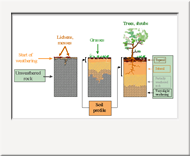Time:
Chemical and physical weathering of rock particles occurs over time and is also increased by the burrowing of animals and through penetration by plant roots.
Time and topography are intertwined - the topography of a piece of land depends upon the age of the landform.
Topography in turn affects soil formation: the alluvial valleys at the bases of hills such as around Gisborne have young, relatively fertile soils. Geologically old areas such as parts of Northland tend to have older, less fertile soils.
In regions around glaciers poorly drained depressions may form lakes. Leaching of clay from the moderate to steep slopes common to glacial areas often occurs.
In regions >50,000 years old, many of the depressions get filled, valley slopes become gentler and a much greater concentration of clay ends up having been leached into the subsoil.
Weathering Over Time:
Chemical and physical weathering occur over time and this combined with the effect of plant roots progressively modify the parent material forming a deeper and deeper soil. Specifically, plants contribute to weathering by:
click diagram to enlarge
 |
|
Topography-Time: Weathering by Plants
|
|
 |
releasing chemicals such as acids which dissolve rocks |
 |
growing into minute cracks. |
As each plant community over time progressively modifies parent material, organic material builds up and topsoils form. The succession of plant communities above the ground is mirrored by a change in soil below the ground.
An indication of just how deep plant roots can penetrate parent rock material can be seen by observing pohutakawa roots on cliff edges.